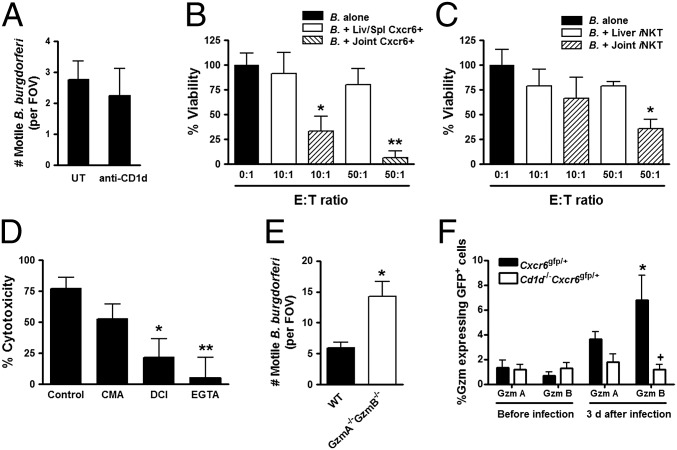Fig. 5.
Direct bactericidal activity provided by joint iNKT cells is granzyme (Gzm)-dependent. (A) Effect of anti-CD1d antibody on the clearance of B. burgdorferi (“B.”) spirochetes in knee joint tissue (n ≥ 3 mice per group). (B) Cytotoxic effect of CXCR6+ cells derived from the liver, spleen, or joint tissue on Tomato-expressing B. burgdorferi. (C) Cytotoxic effect of purified iNKT cells (requiring additional steps) derived from the liver or joint tissue on Tomato-expressing B. burgdorferi. (D) The effect of CMA, DCI, or EGTA on iNKT cell cytotoxicity. Tomato-expressing B. burgdorferi (5 × 103 per milliliter) were incubated with CXCR6+ (B) or CXCR6+TCR-β+ (C and D) cells derived from liver, spleen, or joint at an E:T ratio of 10:1–50:1 at 37 °C and 5% CO2. The number of surviving B. burgdorferi was counted using hemocytometer and spinning-disk confocal microscopy system at 2 d after incubation. CMA, DCI, or EGTA was pretreated with the coculture (n ≥ 5 FOVs per group). **P < 0.01, *P < 0.05 vs. target cells alone (B and C) or vehicle-treated control (D) by Bonferroni’s multiple-comparison test. Error bars, SEM. (E) The number of intact/active mobile spirochetes in wild-type and Gzma−/−Gzmb−/− knee joints at 3 d after B. burgdorferi infection was measured (n ≥ 3 mice per group). *P < 0.05 vs. WT by t test. Error bars, SEM. (F) Gzm expression of GFP+ cells in CXCR6-GFP and Cd1d−/−CXCR6-GFP mouse joints. Gzm A- or B-expressed cells were analyzed by flow cytometry at 0 d and 3 d after B. burgdorferi infection. *P < 0.05 vs. before infection, +P < 0.05 vs. CXCR6-GFP by t test. Error bars, SEM.

